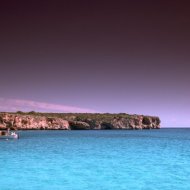Bodies of water in Spain
 Spain boasts some of Europe's most scenic coastlines. (Photo: Images )
Spain boasts some of Europe's most scenic coastlines. (Photo: Images )
Related Articles
Spain occupies some 85 percent of the Iberian Peninsula, which it shares with Portugal, and is sandwiched between two massive water bodies: the Mediterranean Sea and the Atlantic Ocean. Spain is believed to have more than 500 lakes and 1, 800 rivers, the majority of which flow into the Atlantic, as well as nearly all of Europe’s saline steppe wetlands. While Spain's most important water bodies vary significantly in size, shape and type, they are all integral to the country's agriculture, wildlife, ecosystem and tourism industry.
Bay of Biscay
The Bay of Biscay is Spain's second-largest water body after the Canarian section of the Mediterranean Sea. The bay borders Spain's northern shore from San Sebastian to Cabo de Peñas and is estimated to have a surface area of approximately 86, 000 square miles, with a maximum depth of more than 15, 500 feet. The winter months are known to bring especially rough waters, earning it the nickname "Valley of Death" from German U-boat men during World War II. The water is a mix of subtropical and subpolar rotating ocean currents, ultimately creating a unique habitat for countless species of sea-dwellers. Vacationers often can be found boating, jet-skiing and fishing for crab or bluefin tuna in the bay.
Lake Sanabria
Lake Sanabria is the largest lake on the Iberian Peninsula, with a surface area of 3, 187, 500 square meters and a maximum depth of 167 feet. The lake was formed by slow-moving glaciers over many thousands of years and sits at the crossroads between vastly different Mediterranean and Atlantic ecosystems. The natural beaches surrounding the lake draw waves of European vacationers during summer months, with popular water-based activities that include windsurfing, sailing, kayaking and water-skiing. A dam on Lake Sanabria broke in 1959, sending a massive deluge through the Tera Valley, submerging the lakeside village of Ribadelago and killing more than 140 people.
Tagus River
The Tagus River is the longest on the Iberian Peninsula, flowing some 565 miles, and is outdone in total water volume only by the Ebro River. Originating in Spain's eastern mountains near Albarracin, the Tagus flows in a southwesterly direction to its basin in Madrid and eventually dumps into the North Atlantic Ocean in Lisbon, Portugal. Locals use it heavily for fishing, transportation and agriculture, although primarily in the lower portion, as the deep gorges and rocky limestone riverbeds make the upper portion all but unnavigable. Wildlife around the river is diverse and plentiful, home to both European and North African species such as ibex, chamois and fallow deer. Fish species include trout and black bass.
Canales Reservoir
The Canales Reservoir, located in the Andalusia region of Spain just a few miles east of Granada, is one of the country's youngest water bodies. It was originally created simply to provide safe, reliable drinking water to surrounding communities, but more recently has attracted outdoor enthusiasts because of its scenic location along the northwest slopes of Sierra Nevada National Park. The shoreline of this artificial lake is steep, rugged and underdeveloped, making it attractive to rock climbers, hikers and mountain bikers. In addition, several small towns near the reservoir draw vacationers regularly thanks to their ethnic marketplaces, authentic old-world restaurants and a steady stream of sunshine throughout most of the year.
Source: traveltips.usatoday.com
https://mines2.com/
Play Brawl pirates Online
Related posts:








